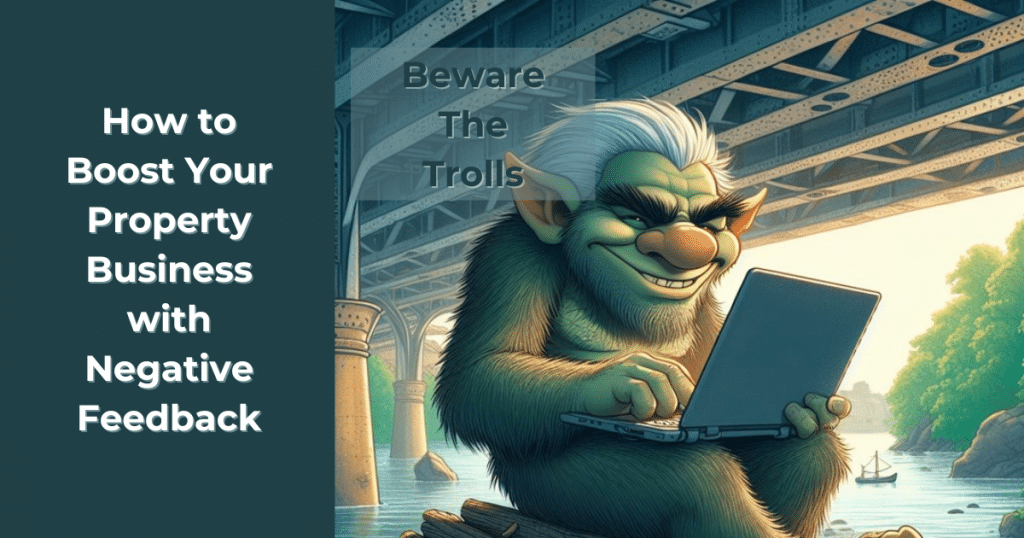This post on handling negative feedback is a modified section from my book, Automated Property Leads Forever.
When I sat down to start planning what I would discuss and how to handle the topic, I quickly realised that I had already done the work previously. So, I copied and pasted the relevant section from my book and edited it into a post. As it turns out, not a great deal needed changing, but I added to the content anyway.
Handling negativity on your social channels is largely down to how you frame it. Oh! And apologies in advance for the heavy use of analogies here, but I want you to remember these guidelines for handling negative feedback, so I’ve turned them into mini-stories, sort of.
When stepping into the social media arena, one thing is sure – you will encounter negative feedback.
But know this: negative feedback isn’t always bad.
Let’s get started and dive into why.
Why Negative Feedback Isn’t Always Bad
It would be best if you thought of negative feedback as a mirror. You may not like that it reflects an unflattering image, but it’s honest. It shows you where the knots are in your smooth presentation and the wrinkles in your seamless customer service.
So, doesn’t it make sense to use this reflection to better yourself?

The Opportunity Hidden in Criticism
Criticism is your secret ally, an undercover agent, if you will. It roams amidst your audience, uncovers the cracks you fail to see, and brings you raw, valuable intel. Constructive criticism isn’t an attack; it’s a gold mine of insights you’d be wise to dig into.
Types of Negative Feedback on Social Media
Millions of users engage daily on social media, and we know you can’t always please all the people, so negative feedback is inevitable. Such feedback can manifest in various forms and flavours, each requiring a distinct approach and reaction. Understanding the different types of negative feedback on social media is essential for managing your online presence effectively. Here are some common types of negative feedback encountered on social media platforms:
Constructive Criticism
The candid friend who tells you there’s spinach stuck in your teeth. That’s constructive criticism. It might sting, but it’s got your best interests at heart. This kind of feedback is like a compass guiding your social media strategy towards better shores. Learn to welcome and embrace this form of criticism.

Constructive criticism is a wise old teacher. It points out your blind spots and guides you towards improvement. It sharpens your skills and polishes your strategies. Imagine criticism as the chisel that shapes the diamond in the rough.
The result makes the process worthwhile.
Offensive Comments or Trolls
Then, there are the trolls, those who stoke the fire for the sake of creating chaos. They’re like pesky mosquitoes buzzing around, seeking attention. Learning to handle them is a bit like a matador mastering his bullfight – you’ve got to know when to sidestep!
Don’t feed the trolls. Should you choose to engage with a troll, you’re on their turf, and you’ll be playing into their hands. It’s a battle you can never win.
Please don’t do it.
Your options here are to:
- Ignore the comment.
- Respond calmly and factually
- Report, Block and Delete – if it goes against community guidelines
- Use humour (be careful not to escalate the conflict – no mocking or sarcasm)
- Engage your community (reaffirm your values and commitment, thank any positive responders).
Genuine Complaints or Dissatisfaction
Genuine complaints are the honest cries of a customer unhappy with your service. They’re the echoes of dissatisfaction that ripple through your social media channels. Think of these complaints as SOS signals – they’re calls for help that you can’t ignore.
Misunderstandings and Miscommunications
You know how a message can get twisted as it passes from one person to another. Misunderstandings and miscommunications on social media can be similar. Is it just me, or does it seem everyone is ready to be offended on somebody else’s behalf these days?
Check any replies before posting and ensure that they mean precisely what you intend and any misunderstanding will be difficult, if not impossible.

Approaching Negative Feedback: The Do’s and Don’ts
Tackling negative feedback is a bit like baking a cake. There are some ingredients you should use and others you should avoid to prevent a kitchen disaster.
Embracing a Positive Mindset: The Power of Responding, Not Reacting
Embrace a positive mindset, responding instead of reacting. That’s like adding a dollop of butter to your cake batter – it makes the mix smoother and the cake richer.
Think about a critique or complaint as an opportunity to fix a problem for all future prospects and clients. Gratitude for the opportunity to improve will make your day a much better one over resenting the person who took the time to help you by commenting.
Being Professional: Keeping Emotions in Check
Are you keeping your emotions in check? That’s the sugar in your recipe. It balances out the bitterness and adds a professional sweetness to your responses.
If you reply to criticism in a negative tone with more of the same, you’ll lose all semblance of professionalism and keep adding to the bitterness.
Nobody likes to see that except the trolls.
Turning Negatives into Positives: Solving Issues Publicly

Are you solving issues publicly? That’s the baking powder in your cake – it allows you to rise above the problem, turn negatives into positives, and leaves your audience impressed.
No company is perfect, and demonstrating how you handle problems will impress many. Those who pretend they never have issues and argue every point are likely best avoided.
Not All Battles Are Worth Fighting: When to Ignore Trolls
Choosing your battles can be compared to deciding when to discard a cake that didn’t turn out as planned. Imagine baking a cake that turns out imperfect – lopsided, burnt around the edges, and unsalvageable. You could waste more time and ingredients trying to fix it, or you could choose to toss it and start afresh. Similarly, engaging with trolls online is like trying to repair that ruined cake. Sometimes, letting it go and moving on to a new conversation is better.
Here are a few tips on when it’s right to ignore the trolls:
- Ignore trolls when their comments are clearly abusive, offensive, or intended solely to provoke. Don’t feed toxic behaviour.
- Don’t engage with trolls who repeat the same antagonistic behaviour across multiple posts or interactions. Their intent is not constructive.
- Avoid replying to trolls who seem uninterested in reasonable discussion and unlikely to have their minds changed. It will be unproductive.
- Let go of trying to get the last word with persistent trolls who want attention through continual arguing. Once you’ve crafted your expert response, Disengage.
- Consider ignoring trolls on posts/topics that are emotionally charged or controversial. Defusing is better than inflaming.
Ultimately, it’s about conserving your resources and energy for more productive discussions.
Steps to Effectively Handle Negative Feedback
The following steps will help you maintain your footing, however shaky the ground.
Stay Calm and Composed: The Importance of Emotional Control
Staying calm and composed is the first step. Is this you? If not, you need to practice being calm and less reactionary. That’s your compass. No matter how lost you feel, emotional control always points you in the right direction.
Listen, Understand, and Evaluate: The Three-Step Approach
The three-step approach is to listen, understand, and evaluate. Ensure you don’t get worked up over an imagined slight. Ensure you read and fully comprehend what has been written or said. If you can, reach out and ask for clarification if required.

That’s your hiking gear. It ensures you’re well-equipped to handle any challenging slopes or unexpected falls.
Apologise When Necessary: The Power of Humility
Apologising when necessary is your emergency kit. A little humility can patch up injuries, mend bridges, and soothe ruffled feathers. It’s the balm that heals and restores.
Solution-Oriented Responses: Fixing Problems Swiftly
That’s your pair of sturdy boots. They enable you to move forward and tread swiftly and surely towards resolving issues and reaching a common ground.
The Role of Social Media Policy in Managing Negative Feedback
Think of a social media policy as your campsite. It offers shelter, sets boundaries, and provides a safety net.
Setting Expectations: What Your Audience Should Know
Setting expectations is like laying down the rules for the campsite. It ensures everyone knows what to expect, what’s acceptable, and what’s not. Setting expectations was also part of the Terms of Service when I covered your Website requirements in Reviewing Your Content Foundations.
Guidelines for Your Team: How to Respond to Negative Feedback
Your team’s guidelines are your campfire. It’s the central point around which your group gathers, sharing warmth, understanding the common language of responses, and holding the darkness at bay together.
If everyone knows what is expected and has a process they can follow, the chances of an unexpected escalation is reduced and your reputation will be better protected.
Transforming Negative Feedback into Positive Outcomes
Transforming negative feedback into positive outcomes isn’t just a fancy magic trick; it’s an essential skill for anyone wishing to achieve social celebrity status. It’s about taking criticism and using it as a building block for improvement and growth rather than allowing it to be a stumbling block.
Consider the feedback a valuable insight into your audience’s mind and pain points. What do they need, want, or expect from you? Use this information to better your service or brand, like a chef perfecting their recipe based on diners’ feedback.
For example, if a user comments that your website is challenging to navigate, don’t dismiss it as a mere complaint. Instead, please take it as an opportunity to revisit your website design. Could the user interface be improved? Is the navigation intuitive? Addressing these concerns not only rectifies the issue for the user who points it out but also enhances the experience for future visitors, turning a negative situation into a positive one.

Don’t Miss The Opportunity for Your Brand to Shine
Another aspect of transforming negative feedback is in your response. Each comment or review is a chance for interaction. How you respond can significantly impact public perception of your brand. Acknowledge the statement, appreciate the user for their time, apologise if necessary, and assure them of action towards resolution. This simple step can transform a critic into a fan, broadcasting to your audience that you value their input and are dedicated to their satisfaction.
You can also use the feedback as a stepping stone towards innovation. Often, customers and followers can point out areas of development or enhancement that might not be visible within your organisation. A product feature, a service add-on, or a fresh marketing approach might be hidden within that feedback. The key is to keep an open mind and welcome these criticisms as opportunities for evolution.
Transforming negative feedback into positive outcomes involves proactive response, strategic improvement, and continuous innovation.
With practice and patience, you’ll be so good even the trolls might be impressed.
Lessons Learned: How Criticism Can Improve Your Services
The lessons learned from criticism are your secret recipe, the whispers of wisdom that can spice up your services and cook up some delectable improvements.
Building Trust: Showing Your Audience You Value Their Opinion

Think of building trust as constructing a bridge. Every brick of genuine response, every mortar of solution, every pillar of respect you show towards your audience’s opinion takes you closer to the other side where stronger relationships await.
Case Studies: Brands That Excelled in Handling Negative Feedback
Have you ever wondered how others had weathered the storm? These case studies provide a peek into others’ journeys, like travelogues of brands that have successfully navigated through the turbulent seas of negative feedback.
The Power of Humour: Wendy’s Twitter Feed
One of the greatest exemplars of the power of humour in handling negative feedback is the fast-food chain Wendy’s, particularly in their Twitter interactions. Known for their witty, sharp, and often downright hilarious comebacks, Wendy’s has created a social media persona that is both charming and disarming.
When users toss sarcastic comments or critique Wendy’s way, they often respond with humour, garnering more attention and praise than the initial negative comment. For example, when one user questioned their claim of using “fresh, never frozen” beef, Wendy’s replied with a humorous statement explaining the logistics of fresh beef, ending with a playful jab. The result? Retweets, likes, and a slew of positive comments. They turned a sceptical question into a funny, shareable moment, reinforcing their brand message along the way.
Turning Mistakes Around: Domino’s Pizza Reinvention
In the early 2000s, Domino’s Pizza was on the receiving end of some less-than-stellar reviews. Instead of brushing these aside, they boldly admitted their shortcomings and promised to improve. This marked the beginning of an impressive brand reinvention.
They launched the ‘Oh Yes We Did’ campaign, addressing the criticisms head-on and showcasing their efforts to improve, from revamping their pizza recipe to overhauling their delivery process. They even included customer reviews and feedback in their commercials. This brave and transparent response to negative feedback improved their product and boosted their brand image. Today, Domino’s is one of the biggest pizza chains in the world, a testament to the power of turning mistakes around.

A Humble Pie: Tesla’s Response to Criticism
In the world of electric vehicles, Tesla is a dominant player. However, they’re not immune to criticism. What sets them apart is how they respond to it. Elon Musk, CEO of Tesla, has demonstrated on numerous occasions the company’s readiness to take criticism on the chin and work on improvements.
In one instance, a user complained on Twitter about Tesla drivers using Supercharger spots as parking spaces, causing inconvenience to other users. Musk responded directly to the tweet, acknowledging the issue and promising a solution. Within six days, Tesla introduced a policy to combat this exact problem.
**That was when Elon Musk introduced a per-minute “idle fee” for vehicles remaining connected to a Supercharger after their charging session completed.** Banner?
This swift and humble acceptance of criticism and the immediate action to rectify the issue shows the value Tesla places on user feedback and its commitment to continuous improvement.
The Importance of Regular Social Media Audits
Picture a regular social media audit as your annual health check-up. It’s a deep dive into the health of your social media presence, a preventive measure against possible issues. It uncovers what’s working well, what’s not, and what needs immediate attention.

Identifying Common Complaints: Spotting Patterns in Negative Feedback
Identifying common complaints is like piecing together a jigsaw puzzle. Spotting patterns and picking up on recurring issues are all part of creating a complete picture of your audience’s pain points.
Assessing Your Response Strategy: Is It Working?
An assessment of your response strategy is akin to a reality check. Is it as effective as you think it is? Does it resonate with your audience? This is your chance to face the music and fine-tune your symphony.
The Future of Negative Feedback
Ah, the future—a landscape ripe with possibilities. With the rise of AI and chatbots, the feedback ecosystem is undergoing a seismic shift.
The Rise of AI and Chatbots: What This Means for Handling Feedback
The rise of AI and chatbots? Like the invention of the telephone changed communication forever, AI and chatbots are reshaping the landscape of feedback handling.

With the ability to program everything about your business into an AI and then have it chat with your prospects and customers about related issues, your customer service levels could soon be on a par with the biggest and best companies in the world.
Here’s how AI & Chatbots can work for you:
- Chatbots can respond instantly to customer complaints 24/7, improving responsiveness.
- They are easily programmed to answer common questions and issues consistently. This boosts customer service quality.
- AI enables proactive support by analysing vast volumes of data to detect problems before they arise.
- Chatbots identify critical feedback for human agent follow-up, combining automation with human oversight.
- Companies like Facebook and Starbucks already use this technology to streamline feedback management.
While chatbots increase efficiency in handling repetitive feedback, current AI still has some limitations in comprehending nuances in human communication. More advancement is needed for AI to master subtle contextual details effortlessly, which is evident to humans.
This is a definite watch this space moment.
Check out my post “Predictions for Property Lead Generation Over the Next 5 Years”

for more insights on how things might change.
Staying Ahead: Continual Learning and Improvement in Your Strategy
Staying ahead is like maintaining a healthy diet and exercise routine. It keeps your strategy fit, agile, and ready for any challenge. Continual learning? That’s the fuel that powers your journey towards improved feedback management.
And if you should happen to get a few tips from an audiobook while you’re at it, all the better. If you’ve forgotten, my recommendation is Audible – other providers are available.
Final Thoughts: Turning Social Media Challenges into Success Stories
As we close this post, remember that every challenge on social media is an opportunity. A chance to turn a frown upside down, a disgruntled customer into a loyal fan. It is an opportunity to show your human side and become a social celebrity.
After all, diamonds are formed under pressure, and your journey through negative feedback is your chance to shine.









